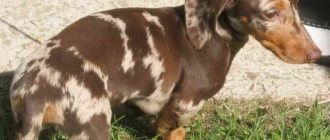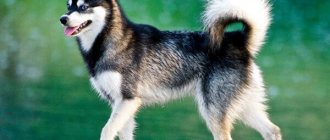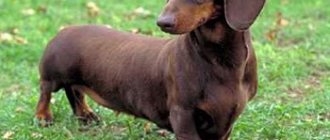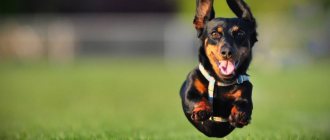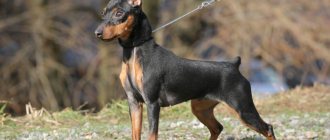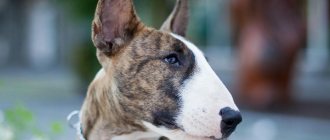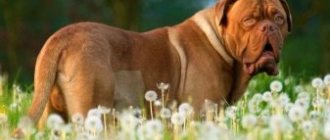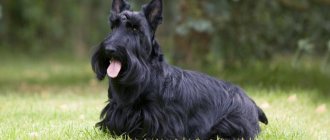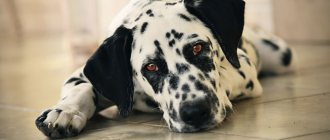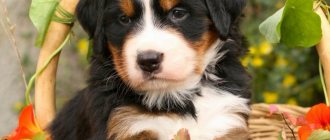Story
The dwarf dachshund has two ancestors - the dachshund and the pinscher. Breeders wanted to create a new breed of hunting dog. Tiny pursuers of game, due to their size, expend less energy, they are more nimble and crawl into tight animal holes. After several experiments, it was possible to achieve, in comparison with an ordinary dachshund, the appearance of a dog with miniature stature. But hunting genes did not work out. Then it was decided to crossbreed the smallest representatives of these breeds.
As a result, the breeders achieved what they wanted. A dwarf individual appeared before them. In the 19th century, the final standard for this breed was established in Germany.
History of the origin of the dwarf dachshund
Dwarf dachshunds were bred in Germany for burrowing and hunting small animals. Selection work on breeding miniature individuals began at the end of the 19th century. The smallest individuals of standard dachshunds were selected for crossing, and attention was paid not only to the appearance, but also to the working qualities of the dogs.
Today there are two breeding directions. Some breeders continue the hunting line of dachshunds, others breed dogs, focusing on their attractive appearance and not paying attention to working qualities.
Description of the dachshund
The appearance of the animal is quite original. The dwarf dachshund is similar to the regular dachshund. She has a playful, perky character, cheerful and cheerful. The elongated body on short legs gives the dog a comical appearance, but, like all dwarf breeds, it can stand up for itself, as well as for its owner. The miniature dachshund feels great in the house, but shows jealousy towards other four-legged and feathered animals if a person pays more attention to them.
Varieties
The small dachshund is classified by color, coat size and overall dimensions. There are options such as:
- smooth-haired;
- long-haired;
- wire-haired.
Based on color, animals are divided into:
- one-color;
- two-color;
- brindle;
- marble.
The color can be black, with red spots, brown, gradually turning into dark or brindle. Plain ones are divided into pure black and red, the color of dark clay. In breeds with long hair, the hair is wavy, not straight like a Yorkie, and covers the entire body rather than isolated areas. The smooth-haired dachshund has a glossy shimmer and is the easiest to care for.
Mini dachshunds are also classified by weight and chest volume. Unlike the usual one, the dwarf one has a volume of up to 35 cm. Rabbit individuals reach 30 cm in chest circumference, with a weight of up to 4 kg. Such representatives have now become exclusively ornamental animals.
Character and appearance
The structure of a miniature dachshund is the same as that of a regular one, with the exception of height and weight. The dog has an elongated body, short limbs, the front ones are smaller than the back ones. The chest is rounded below the knee. The forehead is clearly defined, smoothly turning into an elongated muzzle. The nose is black or brown. The eyes are dark or light brown, sometimes blue. The ears are large and folded. The back is powerful, the belly is drawn in. The tail is not docked, but is wrapped under the paws in the shape of a saber. The size of an adult dog at the withers is 21-16 cm, females are smaller - 14-19 cm. Weight does not exceed 6 kg.
This individual is a typical representative of hunting dogs and fits the description of a standard breed. The dog is stubborn, has a leadership character and will not tolerate other relatives on its territory. She has cunning and endurance.
Usually there are only 1-2 puppies in a dachshund litter, which makes breeding them a troublesome and very responsible task.
Expert opinion
Anna Abramenko
An avid dog lover. Experience in veterinary medicine since 2009.
Ask a Question
Dogs do not like loneliness and constantly need attention. If the owner ignores her, she may become uncontrollable, and out of longing for him, she will begin to tear furniture and slippers. Therefore, before you close her for the whole day, you need to give her more attention before leaving, play, walk and show your love in every possible way.
Sizes of an adult standard, rabbit and miniature dachshund
The standard size for dachshunds is the chest volume:
- For an ordinary standard dachshund it will be over 35 cm
- For a dwarf - 30-35 cm
- In rabbit - up to 30 cm
Increase in standard rate:
- Males - 22-27 cm
- Females - 20-25 cm
Growth of the dwarf dachshund:
- Males -16-21 cm
- Females - 14-19 cm
Growth of the rabbit dachshund:
- Males - 12-15 cm
- Females - 10-13 cm
All values are measured after 15 months . Apart from the size, nothing separates these dogs; the breed standard is the same for everyone. All dachshunds, regardless of size, must retain the characteristics inherent to the breed.
The dog should not look overly bulky or overly frail, like a weasel. Dachshunds have well-developed muscles and short, strong limbs.
The chest is wider than the waist. The transition from the chest to the moderately toned abdomen is smooth. The physique is very harmonious.
For dachshunds, consistency of all body proportions is very important. This is a rectangular dog.
The height of the withers to the length of the body should be 1:1.7-1.8, where 1 is the height at the withers, 1.7-1.8 is the length of the body, with an elongation index of 170-180%.
Education and training
Training begins from the first days the puppy is in the house. First you need to accustom him to a nickname; it should be short and memorable. At the same time, you should adapt the baby to his place, meal times and collar, show who is his owner.
Expert opinion
Anna Abramenko
An avid dog lover. Experience in veterinary medicine since 2009.
Ask a Question
To teach a dachshund hunting skills, you need to bait it with a piece of meat, place it close to the dog and say the command “search”.
It is also recommended to constantly use short instructions such as “fu”, “to me”, “place”, etc. At first, the dog will perceive them at home. Then it is recommended to move the lessons outside, where there are extraneous sounds, barking dogs and the noise of cars.
Expert opinion
Anna Abramenko
An avid dog lover. Experience in veterinary medicine since 2009.
Ask a Question
You can reward your dog for correctly following commands with treats, praise, and a calm tone.
When training a dachshund, it is forbidden to hit the dog or shout at it.
Care and maintenance
For smooth-haired representatives of the breed, it is enough to wipe them with a rubber glove so that the dead hairs fall off. It should not be bathed often - the fat secreted by the glands provides the short-haired species with additional warmth and microflora. After brushing the coat, the dog can be rubbed with jojoba or burdock oil.
Long-haired dogs need to brush their fur with a pet brush to prevent dust and mites brought in from the street from accumulating on it. It is recommended to trim the claws only of puppies; in adults they grind down on their own. Also a mandatory procedure is wiping the ears and eyes with a cotton swab dipped in warm water or chamomile decoction.
Expert opinion
Anna Abramenko
An avid dog lover. Experience in veterinary medicine since 2009.
Ask a Question
Dachshunds do not tolerate low temperatures well. Therefore, in winter they should be walked in overalls.
Before you start letting your puppy out of the house, you should take care of all the necessary vaccinations, especially against ticks. Even a smooth-haired dachshund can carry small parasites while walking in thick grass. It is also recommended to promptly treat your dog for worms and fleas.
Nutrition
It is recommended to feed puppies up to one year 4-5 times a day. For an adult dog, it is enough to give food twice a day, especially if it stays in an apartment. To make the coat shine, you can feed kelp and brewer's yeast.
You should not overfeed your decorative dachshund; it is prone to obesity. She should be protected from eating smoked and sweet treats, sausages, and high-percentage dairy products. If your dog suffers from a lack of vitamins during the off-season, you can add almond oil or ½ tsp to the diet. flax seeds.
This is interesting: The best dry food for dachshunds
You only need to feed your dog at certain times.
Expert opinion
Anna Abramenko
An avid dog lover. Experience in veterinary medicine since 2009.
Ask a Question
Snacks between meals should not be allowed. If there is food left on the plate, you need to remove it until next time.
Walking and physical activity
It is recommended to walk Dachshund puppies as often as possible to teach them to be clean and sociable. You need to take your pet out immediately after waking up, after 20 minutes. after each feeding, and also before bedtime.
An adult dog is walked at least three times a day. The duration of the walk should be 20-30 minutes.
Important! It is forbidden to force a dog to jump.
Since the dachshund is a hunter by nature, it should be provided with physical activity (games, chasing, etc.). In addition, the breed is prone to obesity. If a dog has a calm lifestyle, then health problems will arise.
Physical exercise
Health and illness
During the development of the breed, the dwarf dachshund inherited some hereditary diseases and predispositions. Due to short legs and limited movement, they often suffer from obesity, which leads to diabetes and cardiovascular diseases.
Due to the difficult redistribution of weight, they experience displacement of the spinal discs. As a result, a nerve may be pinched, leading the dog to complete immobilization. To prevent this from happening, it is necessary to strengthen her paravertebral muscles, run up the stairs a lot with her, and carry a load on her back.
A dog can also inherit epilepsy. They also experience eye diseases and cataracts.
Content
You can keep a dachshund in a house or apartment, but under no circumstances in an enclosure. The dog needs warmth.
Need for physical activity
It is enough to walk your dwarf dachshund two hours a day, alternating between activity and mental exercises. In winter, it is advisable to wear warm overalls on your dog.
It is important to control the activity of pregnant bitches - avoid moving on stairs, jumping and active games with other dogs, especially in the second half of the term.
Breed Dwarf Dachshund - photo, characteristics, price of the dog
Appearance care
Miniature dachshunds with any coat type require grooming. For short-haired dogs, it is enough to wipe and brush them once a week, for long-haired dogs, brush them with a slicker twice a day, and for short-haired dogs, trim them twice a year.
You can only bathe your dachshund if it is heavily soiled or before a show. The claws should not reach the floor - overgrown claws should be trimmed with a nail clipper. A decorative dachshund can relieve itself in a tray - just buy a bathtub and accustom the dog to it.
Nutrition
You can feed your dachshund dry food, but the dog digests natural food better. The optimal number of feedings is twice a day. The diet should include:
- meat, fish, poultry;
- cereals;
- dairy products;
- vegetables;
- vitamins.
Dry food must contain at least 30% meat or meat meal and be of at least a premium class.
Pros and cons of the breed
Advantages:
- Friendliness and enthusiasm. No matter what mood the owner is in, a cheerful appearance and kind eyes can cheer anyone up.
- High intelligence, allowing you to quickly master commands and remember your nickname.
- Get along with children.
- Bravery and the ability to stand up for a person in front of other relatives.
Flaws:
- tendency to diseases of the ears and spine;
- the embedded hunter gene will force the dachshund to dig up the garden;
- cocky character - the dog barks at all passing pets on a walk.
Rules for choosing a dachshund
When buying a dwarf dachshund puppy, you should be guided by one rule - the older the cub, the easier it is to determine its further development. Broods are sold from the age of three months, but it is better to choose a baby when he is 5-6 months old. During this period, dwarfism can be more accurately determined.
In appearance, the puppy should be well-fed, with shiny hair, without bald spots. It is worth paying attention to the teeth; the bite should be even, scissor-shaped.
Dogs with malocclusion are not allowed to hunt.
It is better to choose a puppy from a specialized nursery, where he will receive his first vaccinations.
Interesting facts from the life of dogs
- The first mention of a long dog with short legs was recorded in Ancient Egypt.
- The selection of modern representatives of the breed began in Germany in the 18th century.
- Despite their miniature size, dwarf dachshunds have strong muscles, which makes them hardy hunters.
- Due to its low stature, the animal is not afraid of the fox, which gives it an advantage in pursuing the animal.
- In Germany, the dog is unofficially called "Daxel".
- The name "Dachshund" means "earth dog".
Character and training
Miniature dachshunds have very contradictory natures. Their small stature can deceive the enemy. Despite its size, the pet is very warlike. He will fiercely rush to protect his owner if he sees that he is in danger. In addition, the dwarf dachshund is an excellent watchdog.
Animals are very smart, but at the same time cunning and stubborn. They often try to manipulate their owners. It is very important not to give in, otherwise it will be difficult for a person to become a leader in this pair.
Note! Dachshunds are very noisy dogs; they are happy or indignant loudly and loudly. This emotionality is associated with hunting inclinations.
It is very important to give your dog as much attention as possible. If she feels lonely, this will lead to the development of aggression. The pet may begin to spoil things. That is why experienced owners recommend spending as much time as possible with the dog.
Due to their controversial nature, dachshunds are in dire need of training. If this process is ignored, they will grow up to be vindictive and self-willed. Education will help correct the bad tendencies of the breed.
Since representatives of dwarf pets are very touchy and vindictive, you should not raise your voice or hit them. Any rough actions will lead to the dog becoming angry and cruel. But any achievements of the dachshund should be encouraged with a kind word and stroking.
Pet training
Reviews
Igor: “We got a dwarf dachshund on a summer cottage, and this beast set up a testing ground on the territory, making a bunch of holes. A very funny dog, when he frolics and runs around, he lifts his spirits and is inexpensive to feed.”
Oksana: “In my kennel, the dachshund does not like other dogs, she is only friends with her own, so we keep her away from everyone so that she does not attack. But when guests arrive, she is very friendly to people and asks to be held.”
Marina: “My dwarf dachshund is 8 years old. During this time, I treated her 2 times - for an ear parasite and had stomach upsets when she ate dry food at the same time. Since then, we only give her what we eat ourselves.”
Photo and video review
When buying a dwarf dachshund, a person expects to receive a sea of positivity and joy. And this will definitely happen, but it is worth remembering that this animal is not easy, and requires the same reverent attitude towards itself as to a child.
Puppy weight by month
The table is approximate. The weight of a puppy depends on its individual characteristics, its physical activity, and its habitat. The reference point should be the condition of the puppy.
If the puppy is playful and cheerful, has an excellent appetite, and his weight regularly increases, there is no reason to worry . But you should always remember that it is better to underfeed than to overfeed.
| Age | Weight |
| 1 Week | 200-300 g |
| 2 week | 300-700 g |
| 3 week | 600-1.1kg |
| 4 week | 1.1-1.8 kg |
| 2 month | 2.1-2.9 kg |
| 3 month | 2.8-4 kg |
| 4 month | 4.1-5.4 kg |
| 5 month | 5.6-7.1 kg |
| 6 month | 7.2-8.5 kg |
| 7 month | 7.4-8.6 kg |
| 8 month | 7.4-8.8 kg |
| 9 month | 7.5-8.8 kg |
| 10 month | 7.7-9 kg |
| 11 month | 8.1-9 kg |
| 12 month | 8.5-9 kg |
Puppies are fed by the hour:
- Up to three months - 5-6 times a day.
- From three to eight months - 3-4 times.
- An adult dog is transferred to two meals a day.
Portions are calculated based on the proportion of 40 g of feed per kg of animal weight.
